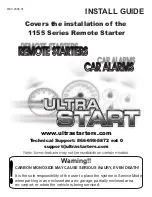
TLR-50 PNEUMATIC REMOTE CONTROLS
Page 1
© 2013 CLEMCO INDUSTRIES CORP.
www.clemcoindustries.com
Manual No. 03358 Rev. I
1.0 INTRODUCTION
1.1 Scope
1.1.1
This manual covers installation, operation,
maintenance, troubleshooting, and replacement parts for
Clemco TLR-50, 1/2" NPT Remote Control System.
1.1.2
These instructions contain important safety
information. All operators and personnel involved with
the abrasive blast process must read and understand
the contents of these instructions, including the
orange cover. It is equally important that the operator
is trained and qualified to safely operate the blast
machine and remote controls, and all other
equipment used with the blast machine. Accessory
manuals for equipment that may be used with the
remote controls are shown below. Manuals are
available on our web site at
www.clemcoindustries.com
.
Blast Machine, Manual No. ................................... 04124
RLX Control Handle, Manual No. .......................... 10574
1.1.3
All personnel involved with the abrasive blasting
process must be made aware of the hazards associated
with abrasive blasting. The Clemco booklet "Abrasive
Blasting Safety Practices" is included with every blast
machine, and contains important safety information
about abrasive blasting that may not be included in
equipment operation manuals. To order additional
copies, visit
www.clemcoindustries.com
or email
.
1.2 Safety
Alerts
1.2.1
Clemco uses safety alert signal words, based on
ANSI Z535.4-1998, to alert the user of a potentially
hazardous situation that may be encountered while
operating this equipment. ANSI’s definitions of the signal
words are as follows:
This is the safety alert symbol. It is
used to alert the user of this equipment
of potential personal injury hazards.
Obey all safety messages that follow this symbol
to avoid possible injury or death.
CAUTION
Caution used without the safety alert symbol
indicates a potentially hazardous situation
which, if not avoided, may result in property
damage.
CAUTION
Caution indicates a potentially hazardous
situation which, if not avoided, may result in
minor or moderate injury.
WARNING
Warning indicates a potentially hazardous
situation which, if not avoided, could result in
death or serious injury.
DANGER
D a n g e r i n dicates an imminently hazardous
situation which, if not avoided, will result in
death or serious injury.
1.3 General
Description
1.3.1
Clemco installs TLR-50 remote controls on 0.5
and 1.0 cu ft. blast machines, models 1028 and 1043.
1.3.2
A remote control system is an OSHA-required
safety device when an operator controls and mans the
nozzle. The control handle, located near the blast
nozzle, is the activator for the remote control valves.
When the operator intentionally or unintentionally
removes hand-held pressure from the remote control
handle, the machine deactivates, stopping air and
abrasive flow through the nozzle. The remote control
system “fails to safe”, which means when any
interruption in the control-air circuit occurs, for reasons
such as a break in the line, the compressor stops
running, or the operator drops the blast hose, the remote
control deactivates the blast machine.
WARNING
Never modify or substitute remote control
parts. Parts from different manufacturers are
not compatible with Clemco equipment. If ANY
part of the remote control system is altered,
involuntary activation, which may cause
serious injury, can occur.
1.3.3
The components of the remote control system
are shown in Figure 1. They include the inlet valve,
diaphragm outlet valve, RLX control handle, 25-ft. and 3-
ft. long twinline control hoses, 2 control hose unions, and
an 18-in. long interconnecting hose.

































